Influences upon Real Estate Investment Decisions and Some Recommendations
Vietnam’s real estate bubble has busted while the local market has been volatile and sensitive to
socioeconomic effects (i.e. changes in policy, fluctuations in money and gold markets, etc.). The paper
tries to assess factors influencing decisions to put money in real estate either as a supplier or a
consumer and then suggest some solutions to the sustainable growth of the realty market in terms of
demand and supply sides. The data is collated via surveys and direct interviews with real estate
investors in HCMC as from Oct. 25, 2011 to Nov. 15, 2011; and the sampling population is 215
investors. The multiple linear regression results show that real estate investment decisions are
influenced by five factors: (1) the governmental policy on the realty market, (2) property tax and landuse fees, (3) national economic factors, (4) socio-cultural factors and population, and (5) impacts of
related markets. The regression function also reveals the significance of each variable to real estate
investment decisions. Accordingly, these provide a solid foundation for solutions to the sustainable
growth of Vietnam’s realty market
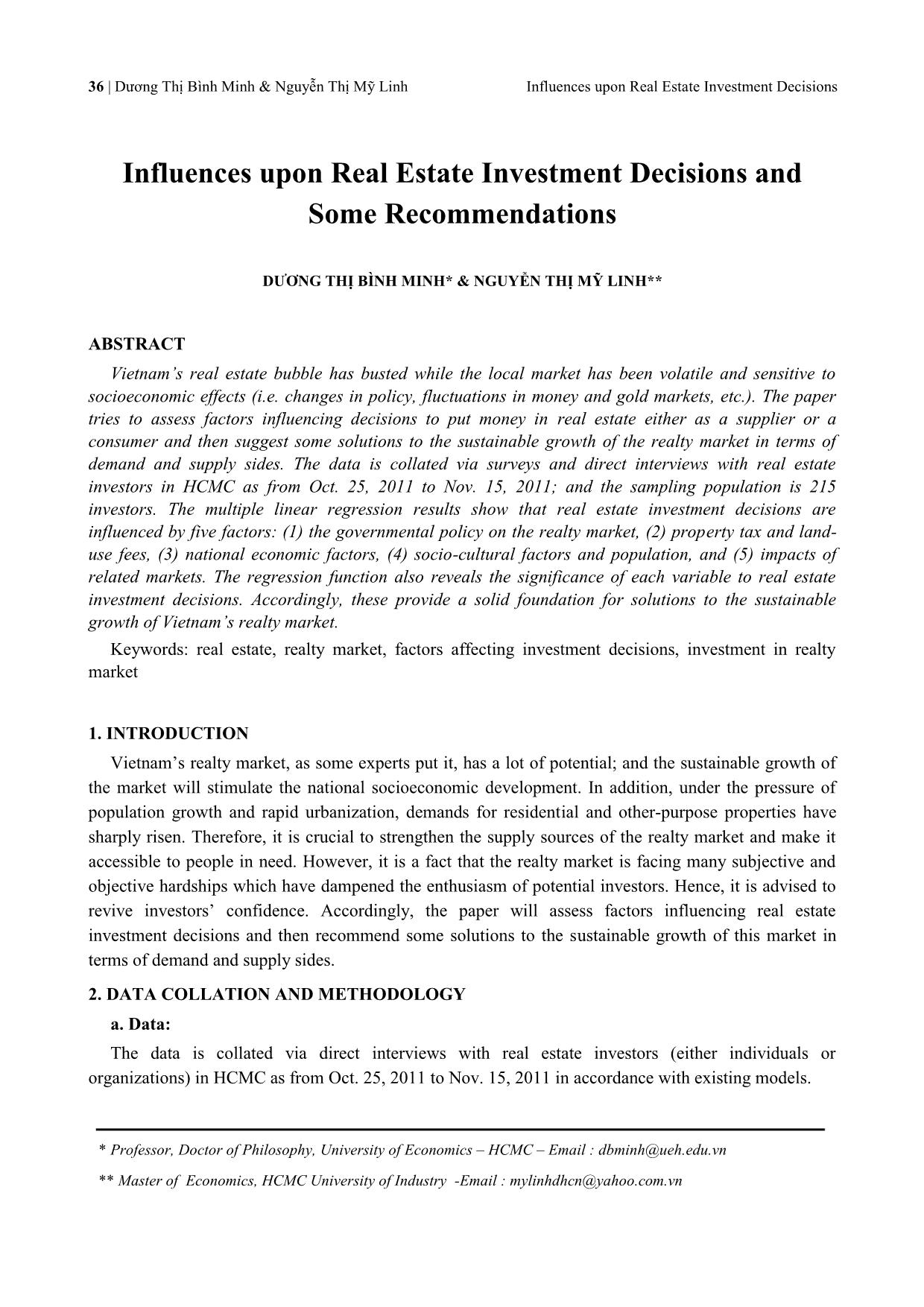
Trang 1
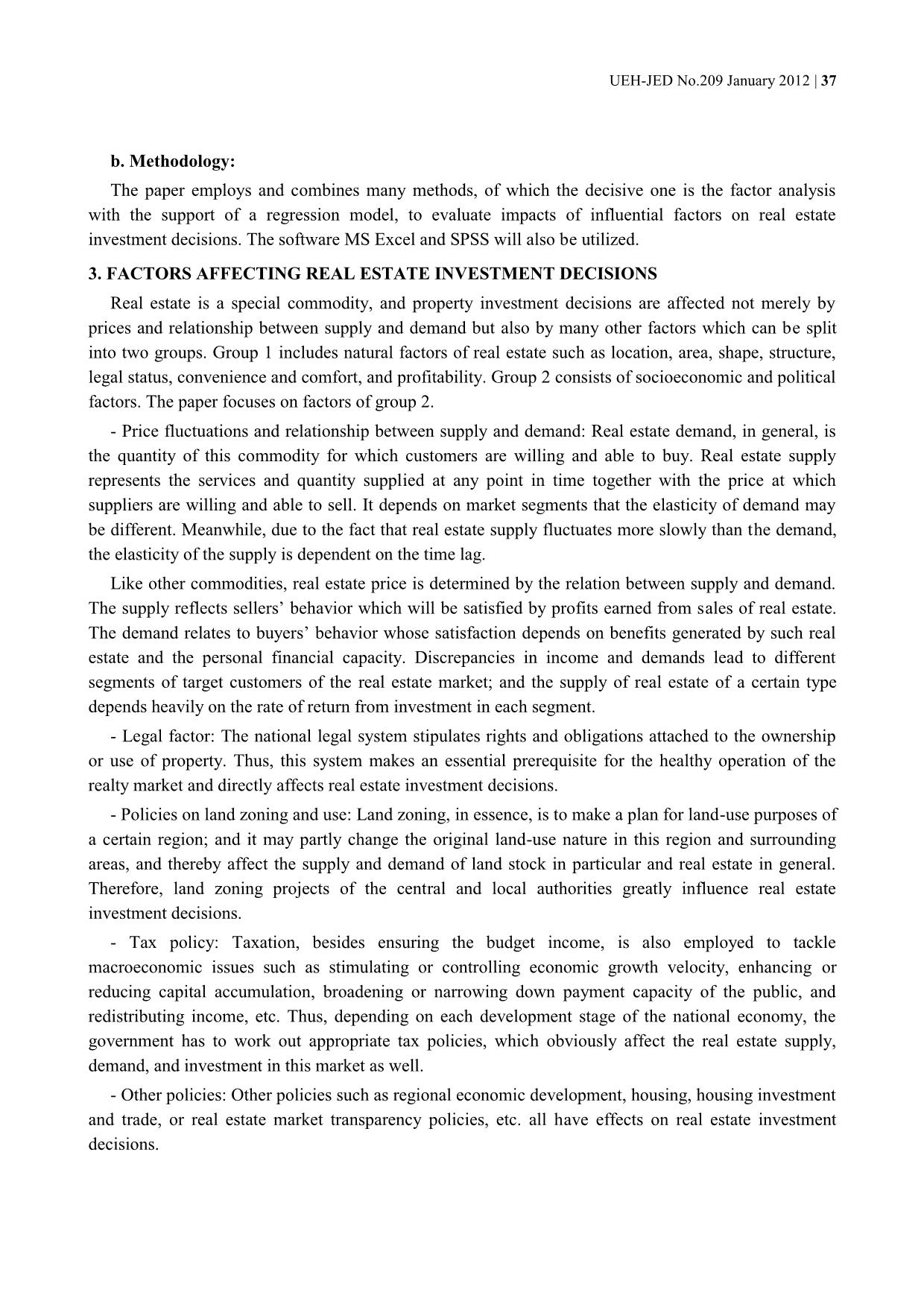
Trang 2
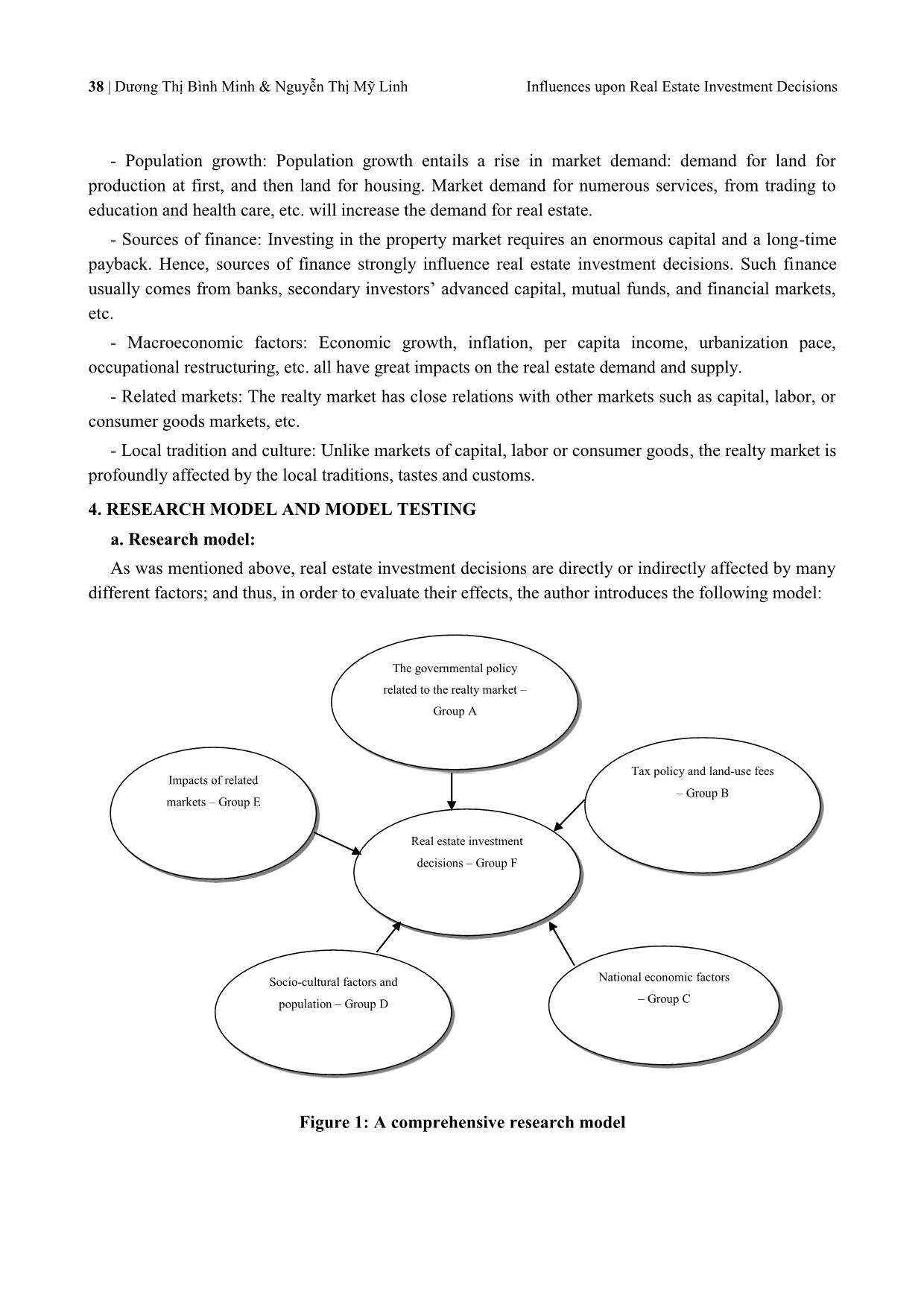
Trang 3
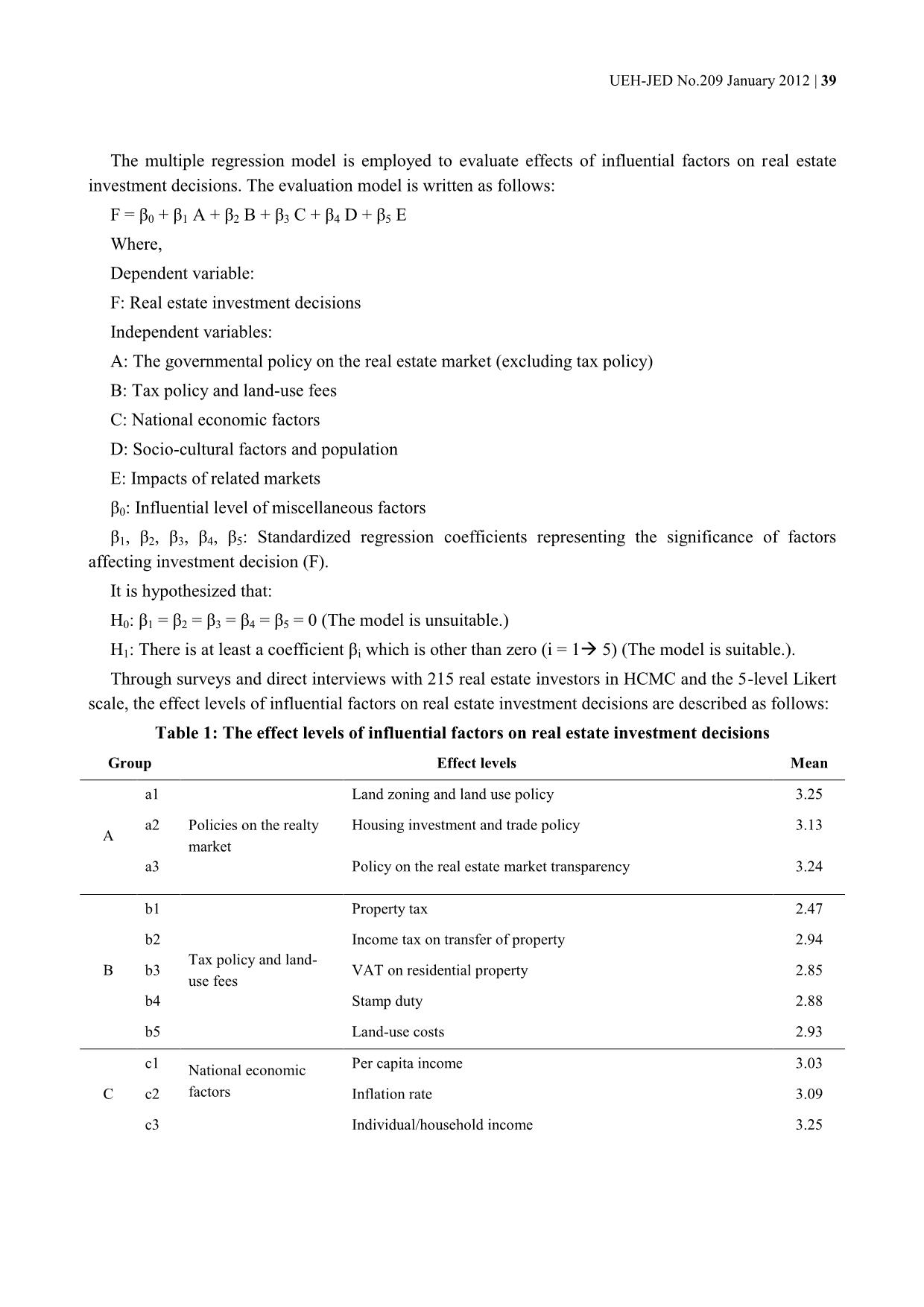
Trang 4
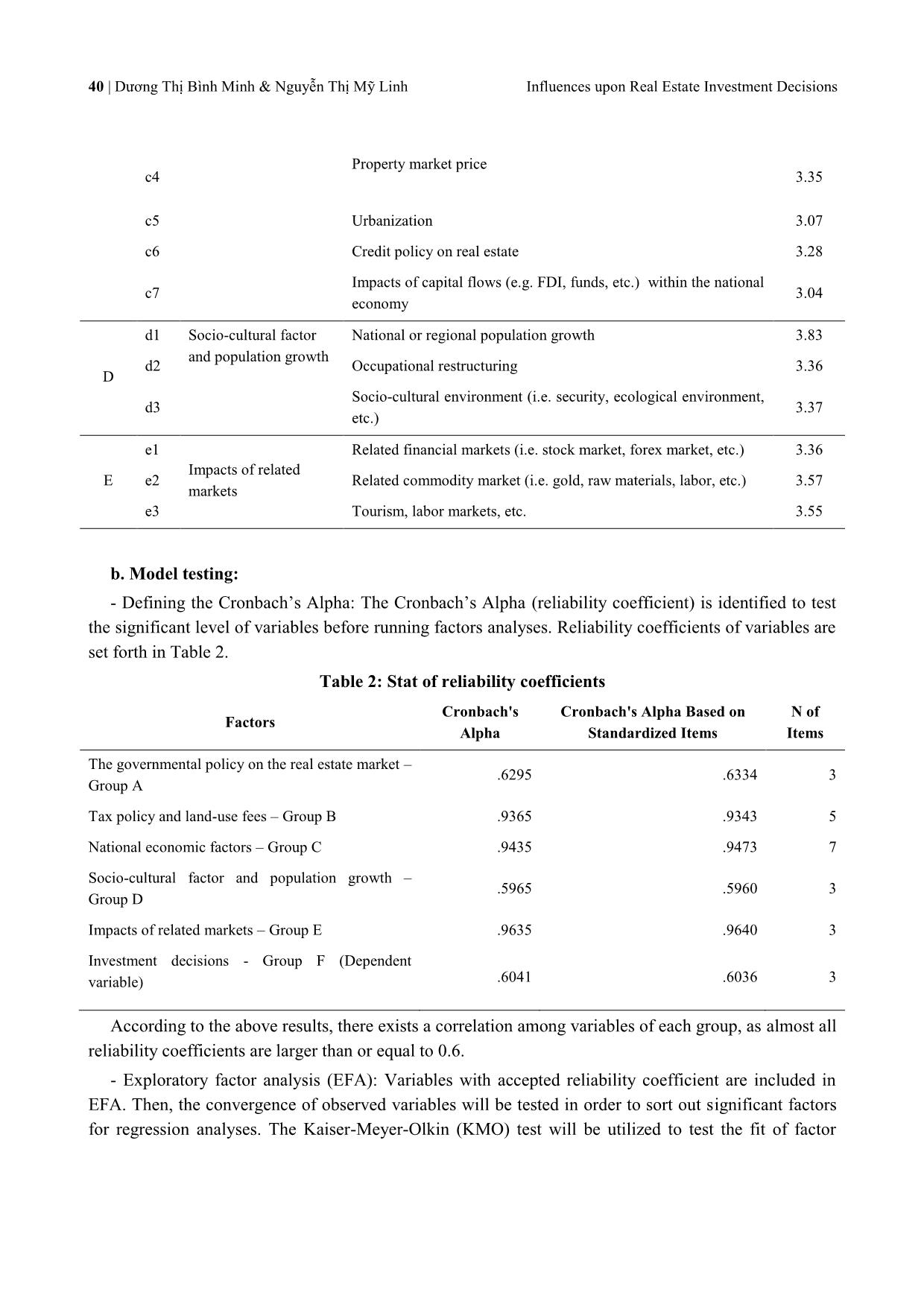
Trang 5
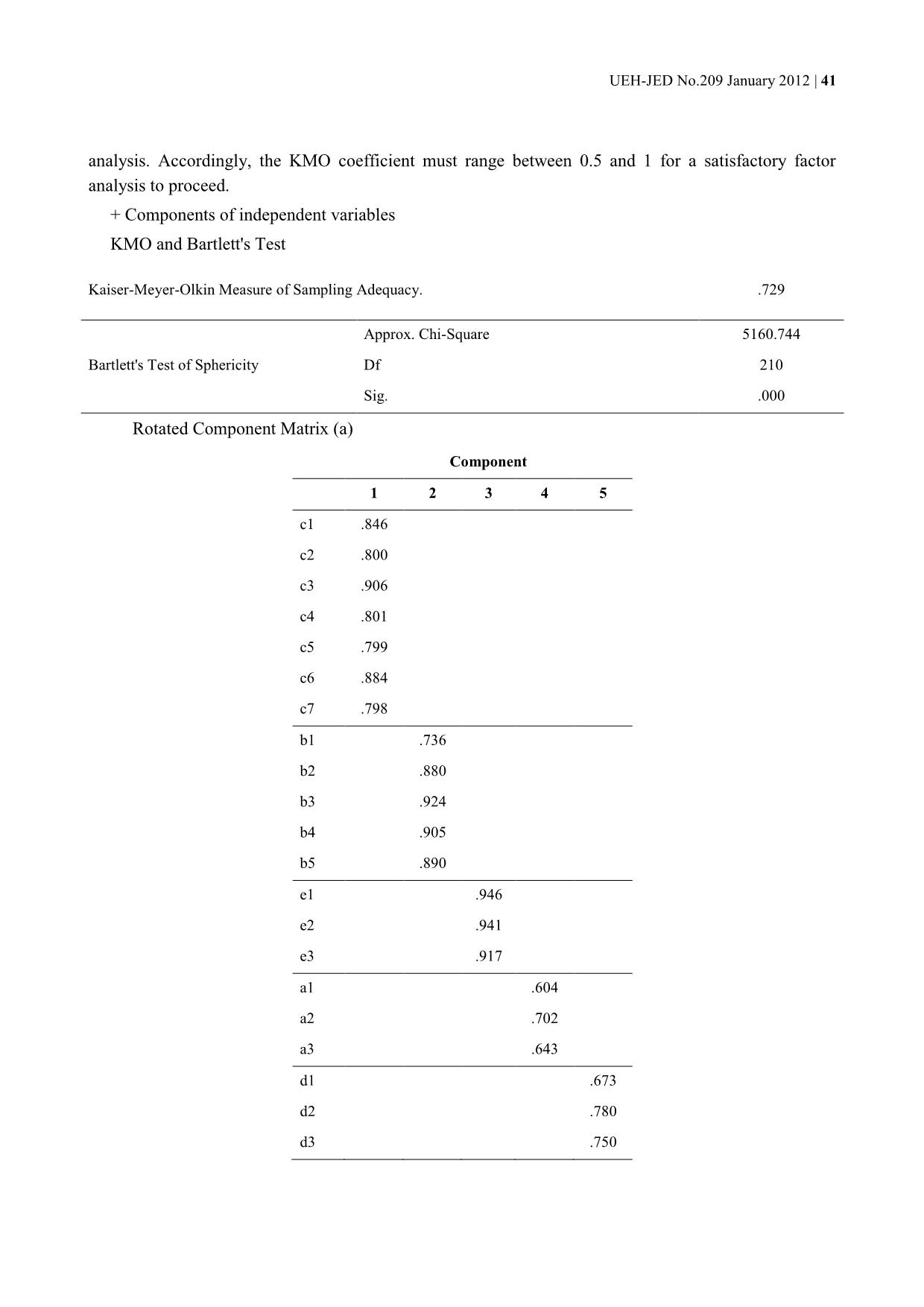
Trang 6
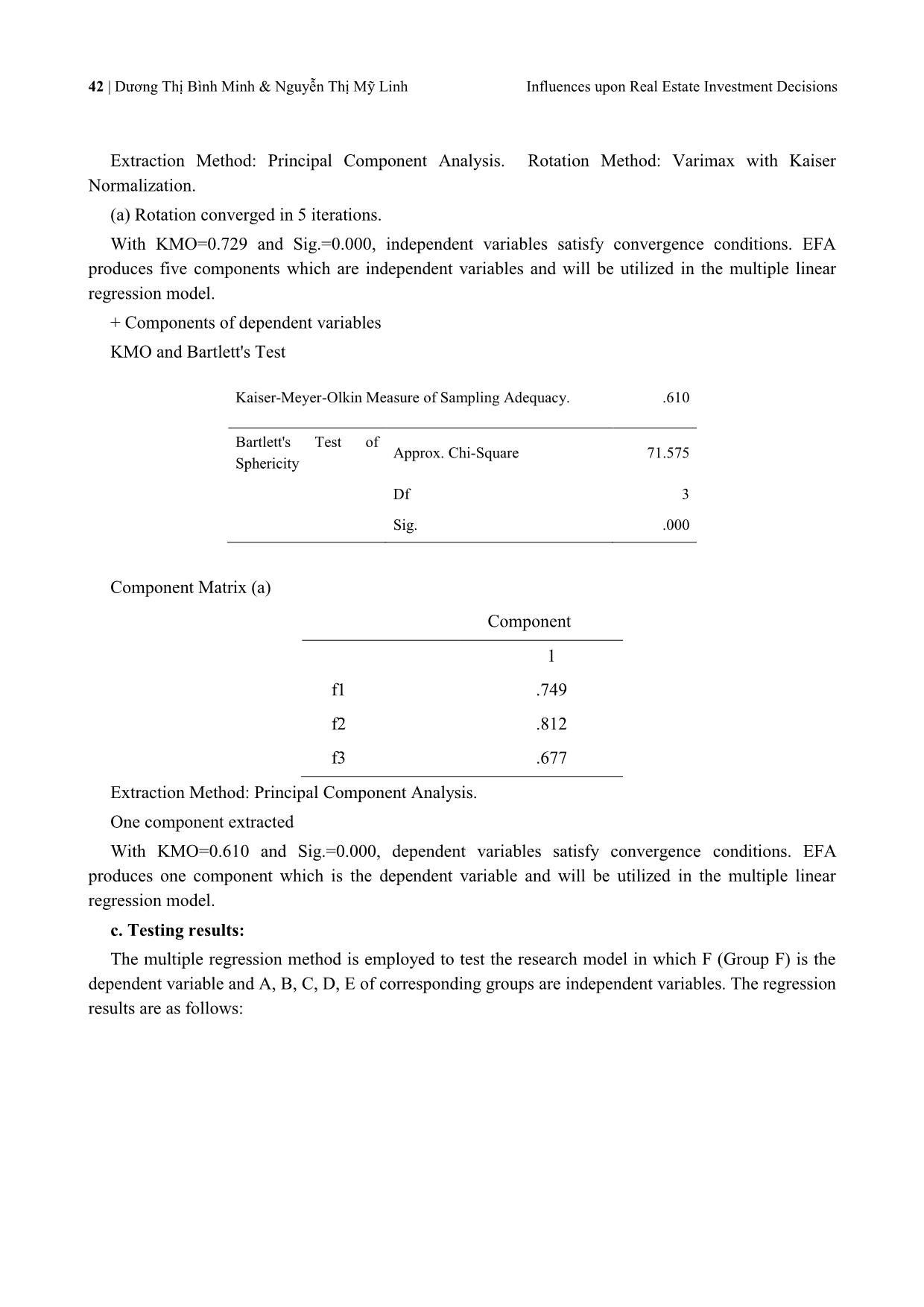
Trang 7
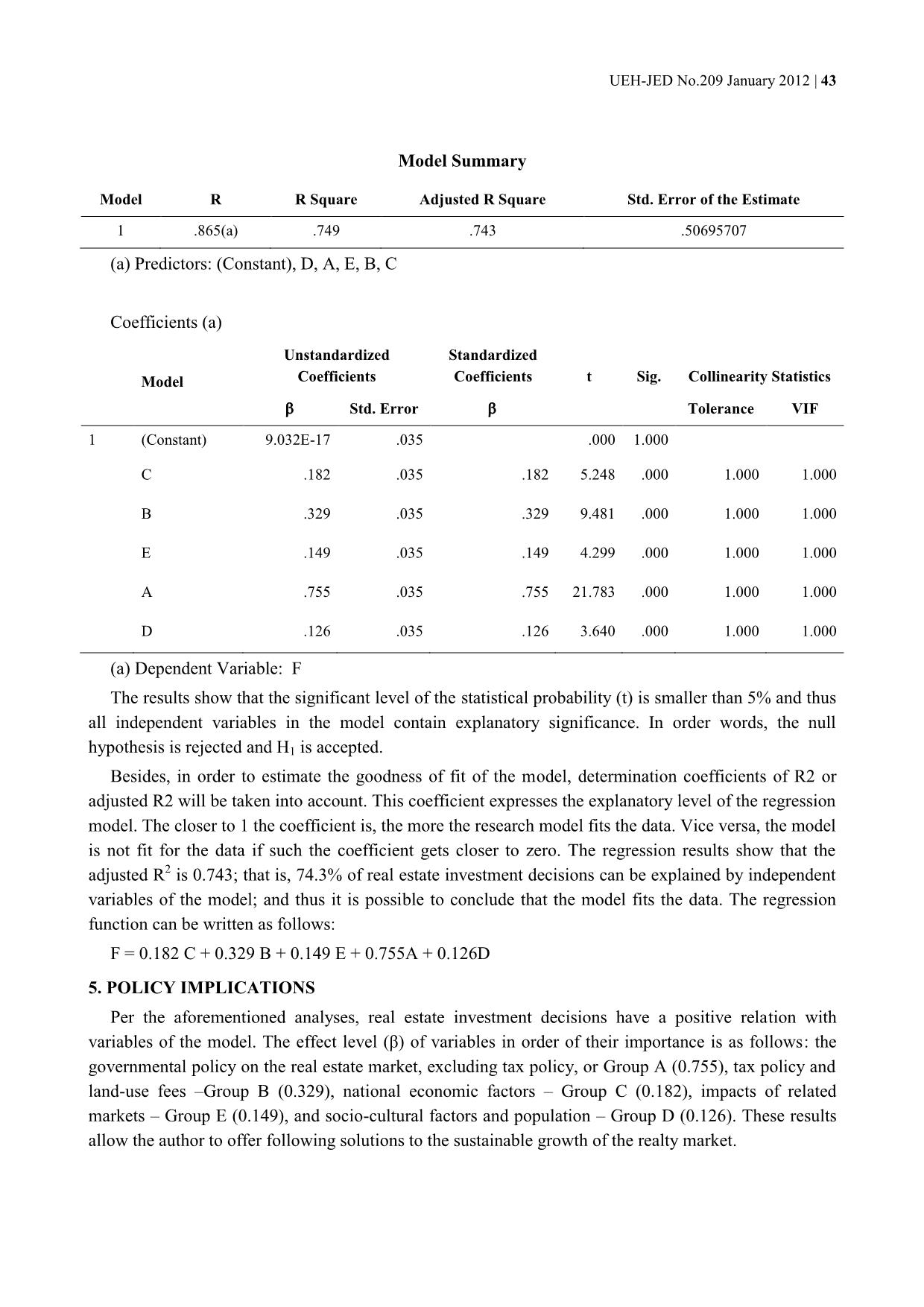
Trang 8
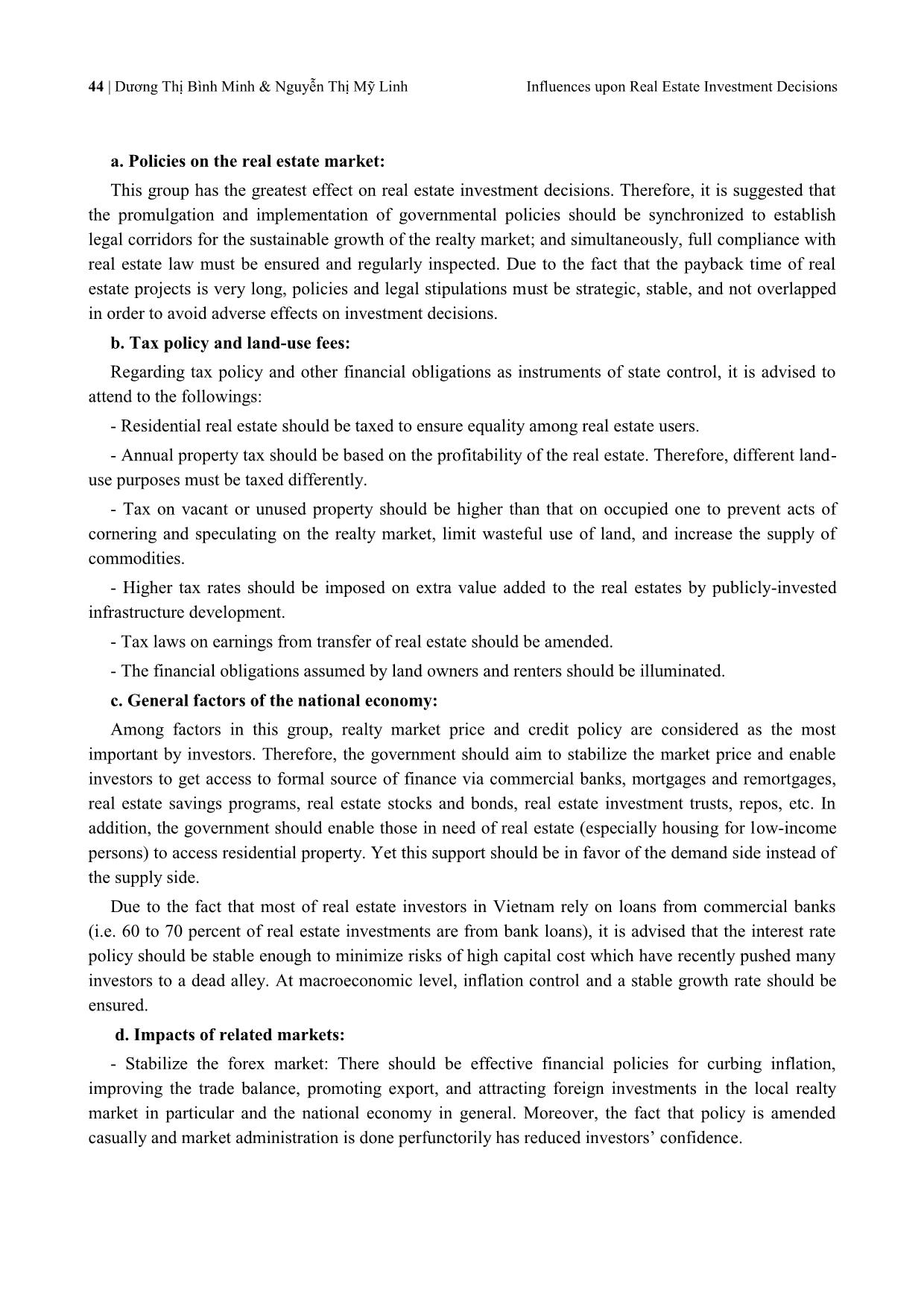
Trang 9

Trang 10
Tóm tắt nội dung tài liệu: Influences upon Real Estate Investment Decisions and Some Recommendations
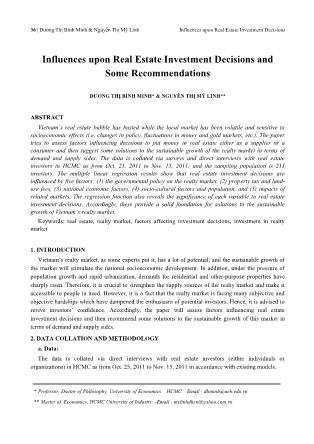
36 | Dương Thị Bình Minh & Nguyễn Thị Mỹ Linh Influences upon Real Estate Investment Decisions Influences upon Real Estate Investment Decisions and Some Recommendations DƯƠNG THỊ BÌNH MINH* & NGUYỄN THỊ MỸ LINH** ABSTRACT Vietnam’s real estate bubble has busted while the local market has been volatile and sensitive to socioeconomic effects (i.e. changes in policy, fluctuations in money and gold markets, etc.). The paper tries to assess factors influencing decisions to put money in real estate either as a supplier or a consumer and then suggest some solutions to the sustainable growth of the realty market in terms of demand and supply sides. The data is collated via surveys and direct interviews with real estate investors in HCMC as from Oct. 25, 2011 to Nov. 15, 2011; and the sampling population is 215 investors. The multiple linear regression results show that real estate investment decisions are influenced by five factors: (1) the governmental policy on the realty market, (2) property tax and land- use fees, (3) national economic factors, (4) socio-cultural factors and population, and (5) impacts of related markets. The regression function also reveals the significance of each variable to real estate investment decisions. Accordingly, these provide a solid foundation for solutions to the sustainable growth of Vietnam’s realty market. Keywords: real estate, realty market, factors affecting investment decisions, investment in realty market 1. INTRODUCTION Vietnam’s realty market, as some experts put it, has a lot of potential; and the sustainable growth of the market will stimulate the national socioeconomic development. In addition, under the pressure of population growth and rapid urbanization, demands for residential and other-purpose properties have sharply risen. Therefore, it is crucial to strengthen the supply sources of the realty market and make it accessible to people in need. However, it is a fact that the realty market is facing many subjective and objective hardships which have dampened the enthusiasm of potential investors. Hence, it is advised to revive investors’ confidence. Accordingly, the paper will assess factors influencing real estate investment decisions and then recommend some solutions to the sustainable growth of this market in terms of demand and supply sides. 2. DATA COLLATION AND METHODOLOGY a. Data: The data is collated via direct interviews with real estate investors (either individuals or organizations) in HCMC as from Oct. 25, 2011 to Nov. 15, 2011 in accordance with existing models. * Professor, Doctor of Philosophy, University of Economics – HCMC – Email : dbminh@ueh.edu.vn ** Master of Economics, HCMC University of Industry -Email : mylinhdhcn@yahoo.com.vn UEH-JED No.209 January 2012 | 37 b. Methodology: The paper employs and combines many methods, of which the decisive one is the factor analysis with the support of a regression model, to evaluate impacts of influential factors on real estate investment decisions. The software MS Excel and SPSS will also be utilized. 3. FACTORS AFFECTING REAL ESTATE INVESTMENT DECISIONS Real estate is a special commodity, and property investment decisions are affected not merely by prices and relationship between supply and demand but also by many other factors which can be split into two groups. Group 1 includes natural factors of real estate such as location, area, shape, structure, legal status, convenience and comfort, and profitability. Group 2 consists of socioeconomic and political factors. The paper focuses on factors of group 2. - Price fluctuations and relationship between supply and demand: Real estate demand, in general, is the quantity of this commodity for which customers are willing and able to buy. Real estate supply represents the services and quantity supplied at any point in time together with the price at which suppliers are willing and able to sell. It depends on market segments that the elasticity of demand may be different. Meanwhile, due to the fact that real estate supply fluctuates more slowly than the demand, the elasticity of the supply is dependent on the time lag. Like other commodities, real estate price is determined by the relation between supply and demand. The supply reflects sellers’ behavior which will be satisfied by profits earned from sales of real estate. The demand relates to buyers’ behavior whose satisfaction depends on benefits generated by such real estate and the personal financial capacity. Discrepancies in income and demands lead to different segments of target customers of the real estate market; and the supply of real estate of a certain type depends heavily on the rate of return from investment in each segment. - Legal factor: The national legal system stipulates rights and obligations attached to the ownership or use of property. Thus, this system makes an essential prerequisite for the healthy operation of the realty market and directly affects real estate investment decisions. - Policies on land zoning and use: Land zoning, in essence, is to make a plan for land-use purposes of a certain region; and it may partly change the original land-use nature in this region and surrounding areas, and thereby affect the supply and demand of land stock in particular and real estate in general. Therefore, land zoning projects of the central and local authorities greatly influence real estate investment decisions. - Tax policy: Taxation, besides ensuring the budget income, is also employed to tackle macroeconomic issues such as stimulating or controlling economic growth velocity, enhancing or reducing capital accumulation, broadening or narrowing down payment capacity of the public, and redistributing income, etc. Thus, depending on each development stage of the national economy, the government has to work out appropriate tax policies, which ... 209 January 2012 | 39 The multiple regression model is employed to evaluate effects of influential factors on real estate investment decisions. The evaluation model is written as follows: F = β0 + β1 A + β2 B + β3 C + β4 D + β5 E Where, Dependent variable: F: Real estate investment decisions Independent variables: A: The governmental policy on the real estate market (excluding tax policy) B: Tax policy and land-use fees C: National economic factors D: Socio-cultural factors and population E: Impacts of related markets β0: Influential level of miscellaneous factors β1, β2, β3, β4, β5: Standardized regression coefficients representing the significance of factors affecting investment decision (F). It is hypothesized that: H0: β1 = β2 = β3 = β4 = β5 = 0 (The model is unsuitable.) H1: There is at least a coefficient βi which is other than zero (i = 1 5) (The model is suitable.). Through surveys and direct interviews with 215 real estate investors in HCMC and the 5-level Likert scale, the effect levels of influential factors on real estate investment decisions are described as follows: Table 1: The effect levels of influential factors on real estate investment decisions Group Effect levels Mean A a1 Policies on the realty market Land zoning and land use policy 3.25 a2 Housing investment and trade policy 3.13 a3 Policy on the real estate market transparency 3.24 B b1 Tax policy and land- use fees Property tax 2.47 b2 Income tax on transfer of property 2.94 b3 VAT on residential property 2.85 b4 Stamp duty 2.88 b5 Land-use costs 2.93 C c1 National economic factors Per capita income 3.03 c2 Inflation rate 3.09 c3 Individual/household income 3.25 40 | Dương Thị Bình Minh & Nguyễn Thị Mỹ Linh Influences upon Real Estate Investment Decisions c4 Property market price 3.35 c5 Urbanization 3.07 c6 Credit policy on real estate 3.28 c7 Impacts of capital flows (e.g. FDI, funds, etc.) within the national economy 3.04 D d1 Socio-cultural factor and population growth National or regional population growth 3.83 d2 Occupational restructuring 3.36 d3 Socio-cultural environment (i.e. security, ecological environment, etc.) 3.37 E e1 Impacts of related markets Related financial markets (i.e. stock market, forex market, etc.) 3.36 e2 Related commodity market (i.e. gold, raw materials, labor, etc.) 3.57 e3 Tourism, labor markets, etc. 3.55 b. Model testing: - Defining the Cronbach’s Alpha: The Cronbach’s Alpha (reliability coefficient) is identified to test the significant level of variables before running factors analyses. Reliability coefficients of variables are set forth in Table 2. Table 2: Stat of reliability coefficients Factors Cronbach's Alpha Cronbach's Alpha Based on Standardized Items N of Items The governmental policy on the real estate market – Group A .6295 .6334 3 Tax policy and land-use fees – Group B .9365 .9343 5 National economic factors – Group C .9435 .9473 7 Socio-cultural factor and population growth – Group D .5965 .5960 3 Impacts of related markets – Group E .9635 .9640 3 Investment decisions - Group F (Dependent variable) .6041 .6036 3 According to the above results, there exists a correlation among variables of each group, as almost all reliability coefficients are larger than or equal to 0.6. - Exploratory factor analysis (EFA): Variables with accepted reliability coefficient are included in EFA. Then, the convergence of observed variables will be tested in order to sort out significant factors for regression analyses. The Kaiser-Meyer-Olkin (KMO) test will be utilized to test the fit of factor UEH-JED No.209 January 2012 | 41 analysis. Accordingly, the KMO coefficient must range between 0.5 and 1 for a satisfactory factor analysis to proceed. + Components of independent variables KMO and Bartlett's Test Kaiser-Meyer-Olkin Measure of Sampling Adequacy. .729 Bartlett's Test of Sphericity Approx. Chi-Square 5160.744 Df 210 Sig. .000 Rotated Component Matrix (a) Component 1 2 3 4 5 c1 .846 c2 .800 c3 .906 c4 .801 c5 .799 c6 .884 c7 .798 b1 .736 b2 .880 b3 .924 b4 .905 b5 .890 e1 .946 e2 .941 e3 .917 a1 .604 a2 .702 a3 .643 d1 .673 d2 .780 d3 .750 42 | Dương Thị Bình Minh & Nguyễn Thị Mỹ Linh Influences upon Real Estate Investment Decisions Extraction Method: Principal Component Analysis. Rotation Method: Varimax with Kaiser Normalization. (a) Rotation converged in 5 iterations. With KMO=0.729 and Sig.=0.000, independent variables satisfy convergence conditions. EFA produces five components which are independent variables and will be utilized in the multiple linear regression model. + Components of dependent variables KMO and Bartlett's Test Kaiser-Meyer-Olkin Measure of Sampling Adequacy. .610 Bartlett's Test of Sphericity Approx. Chi-Square 71.575 Df 3 Sig. .000 Component Matrix (a) Component 1 f1 .749 f2 .812 f3 .677 Extraction Method: Principal Component Analysis. One component extracted With KMO=0.610 and Sig.=0.000, dependent variables satisfy convergence conditions. EFA produces one component which is the dependent variable and will be utilized in the multiple linear regression model. c. Testing results: The multiple regression method is employed to test the research model in which F (Group F) is the dependent variable and A, B, C, D, E of corresponding groups are independent variables. The regression results are as follows: UEH-JED No.209 January 2012 | 43 Model Summary Model R R Square Adjusted R Square Std. Error of the Estimate 1 .865(a) .749 .743 .50695707 (a) Predictors: (Constant), D, A, E, B, C Coefficients (a) Model Unstandardized Coefficients Standardized Coefficients t Sig. Collinearity Statistics Std. Error Tolerance VIF 1 (Constant) 9.032E-17 .035 .000 1.000 C .182 .035 .182 5.248 .000 1.000 1.000 B .329 .035 .329 9.481 .000 1.000 1.000 E .149 .035 .149 4.299 .000 1.000 1.000 A .755 .035 .755 21.783 .000 1.000 1.000 D .126 .035 .126 3.640 .000 1.000 1.000 (a) Dependent Variable: F The results show that the significant level of the statistical probability (t) is smaller than 5% and thus all independent variables in the model contain explanatory significance. In order words, the null hypothesis is rejected and H1 is accepted. Besides, in order to estimate the goodness of fit of the model, determination coefficients of R2 or adjusted R2 will be taken into account. This coefficient expresses the explanatory level of the regression model. The closer to 1 the coefficient is, the more the research model fits the data. Vice versa, the model is not fit for the data if such the coefficient gets closer to zero. The regression results show that the adjusted R2 is 0.743; that is, 74.3% of real estate investment decisions can be explained by independent variables of the model; and thus it is possible to conclude that the model fits the data. The regression function can be written as follows: F = 0.182 C + 0.329 B + 0.149 E + 0.755A + 0.126D 5. POLICY IMPLICATIONS Per the aforementioned analyses, real estate investment decisions have a positive relation with variables of the model. The effect level (β) of variables in order of their importance is as follows: the governmental policy on the real estate market, excluding tax policy, or Group A (0.755), tax policy and land-use fees –Group B (0.329), national economic factors – Group C (0.182), impacts of related markets – Group E (0.149), and socio-cultural factors and population – Group D (0.126). These results allow the author to offer following solutions to the sustainable growth of the realty market. 44 | Dương Thị Bình Minh & Nguyễn Thị Mỹ Linh Influences upon Real Estate Investment Decisions a. Policies on the real estate market: This group has the greatest effect on real estate investment decisions. Therefore, it is suggested that the promulgation and implementation of governmental policies should be synchronized to establish legal corridors for the sustainable growth of the realty market; and simultaneously, full compliance with real estate law must be ensured and regularly inspected. Due to the fact that the payback time of real estate projects is very long, policies and legal stipulations must be strategic, stable, and not overlapped in order to avoid adverse effects on investment decisions. b. Tax policy and land-use fees: Regarding tax policy and other financial obligations as instruments of state control, it is advised to attend to the followings: - Residential real estate should be taxed to ensure equality among real estate users. - Annual property tax should be based on the profitability of the real estate. Therefore, different land- use purposes must be taxed differently. - Tax on vacant or unused property should be higher than that on occupied one to prevent acts of cornering and speculating on the realty market, limit wasteful use of land, and increase the supply of commodities. - Higher tax rates should be imposed on extra value added to the real estates by publicly-invested infrastructure development. - Tax laws on earnings from transfer of real estate should be amended. - The financial obligations assumed by land owners and renters should be illuminated. c. General factors of the national economy: Among factors in this group, realty market price and credit policy are considered as the most important by investors. Therefore, the government should aim to stabilize the market price and enable investors to get access to formal source of finance via commercial banks, mortgages and remortgages, real estate savings programs, real estate stocks and bonds, real estate investment trusts, repos, etc. In addition, the government should enable those in need of real estate (especially housing for low-income persons) to access residential property. Yet this support should be in favor of the demand side instead of the supply side. Due to the fact that most of real estate investors in Vietnam rely on loans from commercial banks (i.e. 60 to 70 percent of real estate investments are from bank loans), it is advised that the interest rate policy should be stable enough to minimize risks of high capital cost which have recently pushed many investors to a dead alley. At macroeconomic level, inflation control and a stable growth rate should be ensured. d. Impacts of related markets: - Stabilize the forex market: There should be effective financial policies for curbing inflation, improving the trade balance, promoting export, and attracting foreign investments in the local realty market in particular and the national economy in general. Moreover, the fact that policy is amended casually and market administration is done perfunctorily has reduced investors’ confidence. UEH-JED No.209 January 2012 | 45 - Manage the gold market: Gold is a precious metal which can be used as a means of payment or for reserve and thus can be used to acquire expensive commodities such as real estate. However, while the realty market is destitute of financial sources for its sustainable development, the government should adopt specific measures to effectively administer the gold market, and prevent volatility as well as upheavals in the market which can instigate gold speculation and adversely affect the realty market. - Guarantee the local supply of raw materials: Domestic production of building materials should be encouraged to substitute imports, reduce the trade deficit, improve the supply of foreign exchange, and particularly lower real estate prices that tend to rise incessantly because of increased prices of imported building materials. e. Socio-cultural factors and population: In addition to aforementioned factors, socio-cultural factors and population also affect decisions on investment in the realty market. Therefore, via rational migration policies, occupational restructuring, and high-quality public services, the real estate demand will definitely go up, pushing the supply up and attracting more investors. 6. CONCLUSION The paper has evaluated factors affecting real estate investment decisions and the significance of each factor and recommended several measures to enhance investment in and sales of immovable assets, which can be deemed as a standard to evaluate the sustainable development of the real estate market. Hopefully, through some aforementioned recommendations, the supply of real estate would be more abundant, meeting the national socioeconomic development, and contributing to the sustainable growth of the realty market References Đỗ Hậu & Nguyễn Đình Bồng (2005), Quản lý đất đai và bất động sản đô thị (Management of urban land and property), Xây dựng Publisher. Lê Xuân Bá & Trần Kim Chung (2006), Chính sách thu hút đầu tư vào thị trường bất động sản Việt Nam (Policy on investment in the Vietnamese realty market), Hà Nội: Chính trị Quốc Gia Publisher. Nhiêu Hội Lâm (2004), Kinh tế học đô thị (Urban economics), Chính trị Quốc gia Publisher. Thái Bá Cẩn & Trần Nguyên Nam (2003), Thị trường bất động sản: những vấn đề lý luận và thực tiễn ở Việt Nam (Vietnamese realty market: some theoretical and practical questions), Tài chính Publisher. Vietnam’s Ministry of Construction (2009), Đề án phát triển Thị trường Bất động sản (Plan to develop the realty market). Vietnam’s Ministry of Natural Resources and Environment (2002), Nghiên cứu đổi mới hệ thống quản lý đất đai để hình thành và phát triển thị trường Bất động sản ở Việt Nam (Innovating the land management machinery to develop the realty market), Governmental project (Code 2002/15).
File đính kèm:
 influences_upon_real_estate_investment_decisions_and_some_re.pdf
influences_upon_real_estate_investment_decisions_and_some_re.pdf

